Items
Identifier is exactly
HST494
-
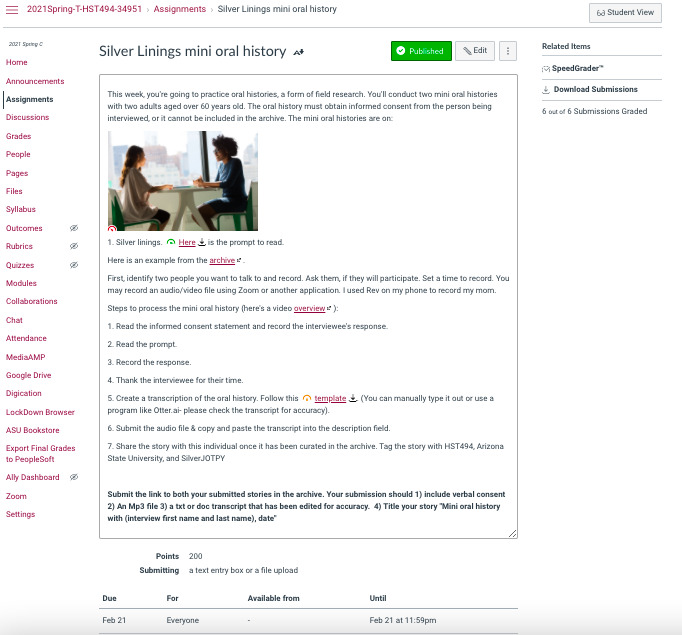 2021-02-21
2021-02-21Mini Oral History Assignment
This week, you're going to practice oral histories, a form of field research. You'll conduct two mini oral histories with two adults aged over 60 years old. The oral history must obtain informed consent from the person being interviewed, or it cannot be included in the archive. The mini oral histories are on: christina-wocintechchat-com-LQ1t-8Ms5PY-unsplash.jpg 1. Silver linings. Here is the prompt to read. Here is an example from the archive (Links to an external site.). First, identify two people you want to talk to and record. Ask them, if they will participate. Set a time to record. You may record an audio/video file using Zoom or another application. I used Rev on my phone to record my mom. Steps to process the mini oral history (here's a video overview (Links to an external site.)): 1. Read the informed consent statement and record the interviewee's response. 2. Read the prompt. 3. Record the response. 4. Thank the interviewee for their time. 5. Create a transcription of the oral history. Follow this template. (You can manually type it out or use a program like Otter.ai- please check the transcript for accuracy). 6. Submit the audio file & copy and paste the transcript into the description field. 7. Share the story with this individual once it has been curated in the archive. Tag the story with HST494, Arizona State University, and SilverJOTPY Submit the link to both your submitted stories in the archive. Your submission should 1) include verbal consent 2) An Mp3 file 3) a txt or doc transcript that has been edited for accuracy. 4) Title your story "Mini oral history with (interview first name and last name), date" -
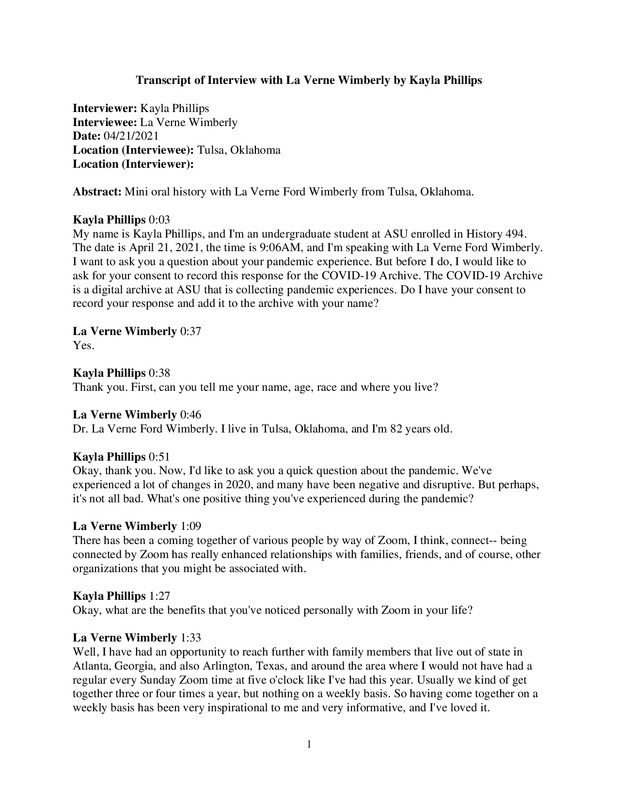 04/21/2021
04/21/2021La Verne Ford Wimberly Oral History, 2021/04/21
Mini oral history with La Verne Ford Wimberly from Tulsa, Oklahoma -
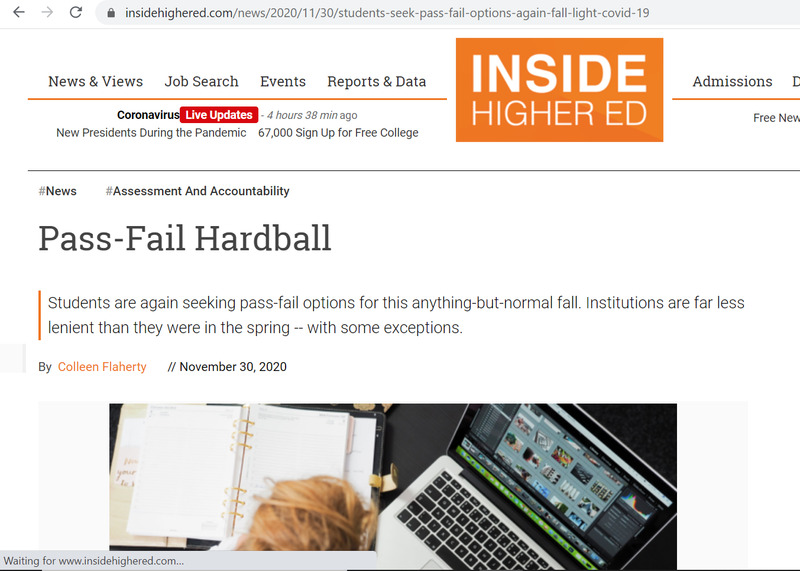 2020-11-30
2020-11-30Pass-Fail Hardball
This article talks about how, prior to the beginning of the Fall 2020 semester, some university students were seeking pass-fail grades in order to accommodate for the lack of stability during the pandemic. It discusses how several universities, such as Clemson University, the University of South Carolina, and the University of North Carolina at Chapel Hill denied their students' requests for pass-fail, while others, such as Baylor University simply acknowledged the requests and did little afterwards, all in the name of "student success". While many universities released statements saying that they understood student stress levels, they were unwilling to adapt the grading procedure to accommodate pass fail grading. -
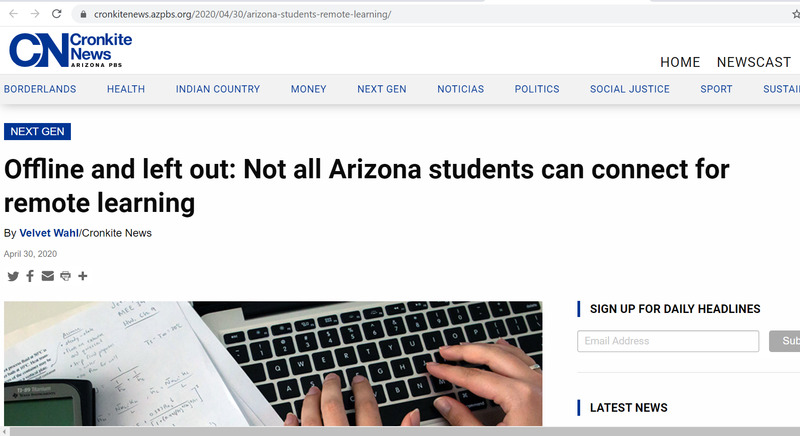 2020-04-30
2020-04-30Offline and left out: Not all Arizona students can connect for remote learning
This article focuses specifically on Arizona's efforts to provide students with internet/technology access in order to achieve online learning. It goes into detail about how several Phoenix schools dealt with the pandemic and online learning in the spring semester of 2020 as well as discusses how some students dealt with internet access issues in creative ways, either due to lack of internet or hotspot issues. Some examples are utilizing hotspots or through just going to public areas despite quarantine conditions to complete schoolwork. -
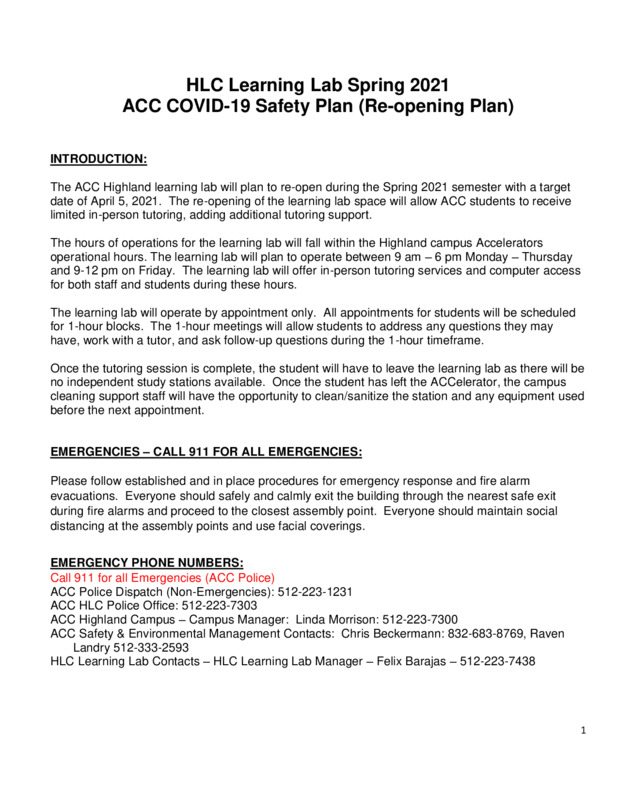 2021-04-18
2021-04-18The Beginning of the End!? Corona Culture Spring 2021
These items are a sampling of documents and links to news articles and public event dates that chronicle the reopening of some parts of the United States in spring 2021. One year after the start of the pandemic (the anniversary itself celebrated in various media), Texas and other parts of the U.S. were trying to return their businesses and services to more normal conditions. A community college's plan for reopening its main campus, a news article about a baseball park increasing its capacity (and having a sold out game), a listing of 2021 tour dates for popular musicians, and a town's decision to end its mask mandate all tell the story of people wanting to return to normal living. However, both government leaders and ordinary people could disagree about whether it was good to relax COVID restrictions as the announcement by a local mayor and the decision of a local school board suggests. These items reflect the challenges of returning to Pre-COVID lifestyles because not everyone was united in the belief that it was safe to live normal lives. This illustrates the interesting conflict between holding on to what makes people be or feels safe and those who believe such restrictions are unnecessary now. -
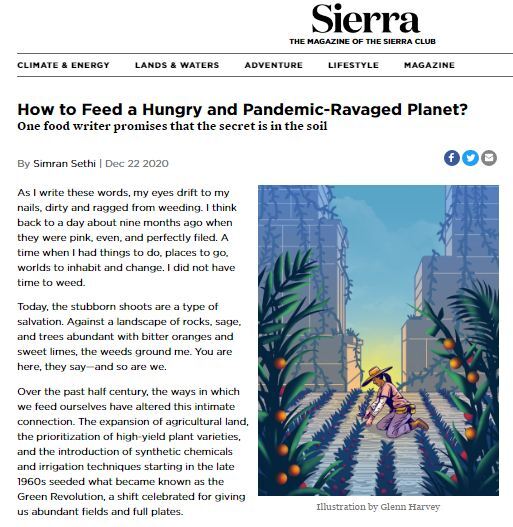 2021-04-18
2021-04-18Gardening: Feeding the Planet and Ourselves
Gardening is something I learned I loved in the spring of 2019, and I noticed many differences during the pandemic. The garden centers were always busy, much busier than the year before. And often, they would be sold out of things such as vegetables. The article I have shared here I found while researching food insecurity. I have long thought that growing your own food is something that should be more widespread, especially among places of poverty. Of course, this article does not mention the fact that people living in extreme poverty barely have enough water to survive, let alone grow crops with. Regardless, this article makes good points about our soil, our diets, and the future of our planet and species. I think one good consequence of the pandemic is more people will turn to gardening, which opens up many more aspects of life. -
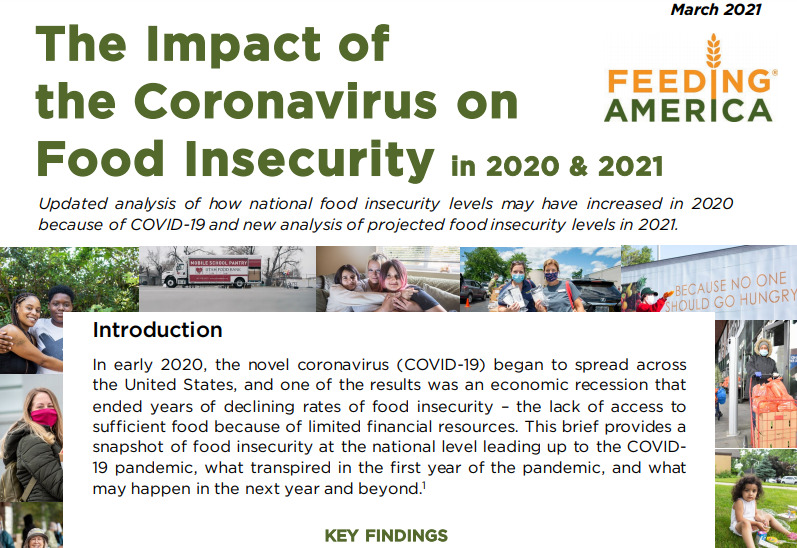 2021-04-18
2021-04-18Feeding America in a Pandemic
Feeding America released briefs in March of 2020, one for food insecurity locally and one nationally due to the pandemic. I have attached the national brief. This is relevant to my research on the consequences of the pandemic. The briefing looks back to 2019 and 2020 and compares notes on food insecurities. Feeding America reviews this and discusses the future of food insecurities. It also talks about how race effects food insecurity, which is something that needs to be talked about. -
 2021-03-09
2021-03-09Birds during the pandemic
This article tells us about wildlife, specifically birds, during the pandemic. As many other animals were, birds were a lot more active when the lockdown began. Some many see this as a good thing but this article goes into detail about the good and bad things that happened to birds during the pandemic. This article is important because it addresses a topic not many people think is important and gives more in depth into this side of nature. -
 2021-04-14
2021-04-14Penguins in Cape Town
This article is an article about the penguins in Cape Town. During the lockdown of the pandemic many animals were seen roaming the streets and some of them were penguins in Cape Town. This article explains what the penguins were doing and shows how the pandemic changed wildlife. -
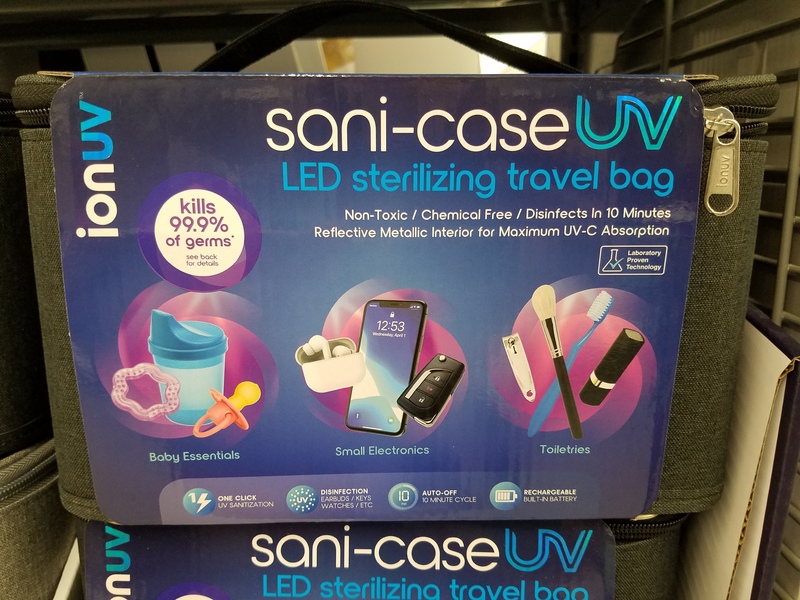 2021-04-17
2021-04-17Corona Culture Products #2 UV Light Sanitizing Box
This is a photograph of a UV light box for sanitizing items that may have been infected with COVID. This professional and stylish looking box was a long time coming. In late spring 2020, as summer was approaching, the CDC and leading doctors announced that the UV rays in sunlight killed the Coronavirus on surfaces within minutes. This led people to hang their masks in their car windows, and leave things outside to sanitize them. It was also believed to be safer to be outside on a sunny summer day because the sunlight would kill the COVID virus in the air and on objects. This primitive method is not available all the time and cannot be taken inside though, so companies created various products that produced UV light that were portable and could be used inside. While a late bloomer to the UV trend, this is a perfect example of the use of UV light against COVID. As you can see from the descriptive packaging, any small items, especially phones, can be put into the box, and after 10 minutes will be sanitized. Great care was taken to point out its effectiveness as seen in the "kills 99.9% of germs" and "laboratory proven technology" statements on the front of the package. Of course, it's not just useful but is discreet and stylish as it looks like a purse or a make-up bag. This item is important because it shows the lengths people went to try and keep their things clean. It also shows the power of fads during Corona. Everyone jumped at the chance to try UV light when it was first announced, yet it decreased in importance for most people after summer 2020. Like all the Corona Culture products, it reveals the depth to which Corona became imbedded into the U.S.'s consciousness. -
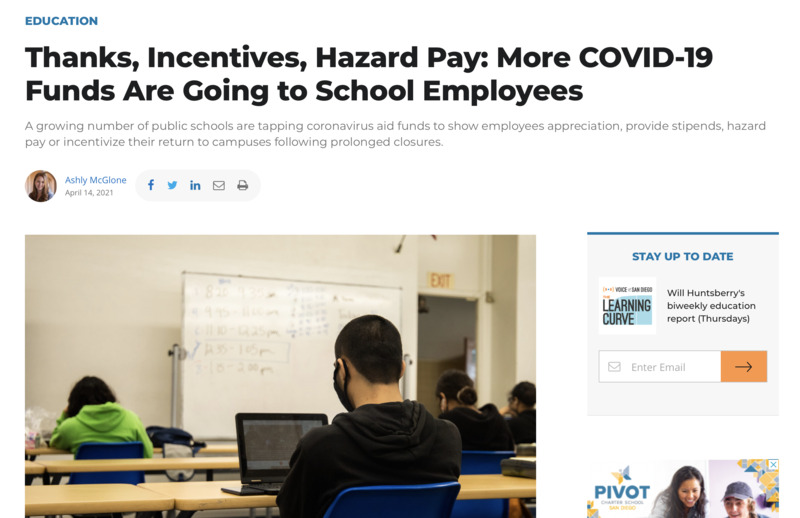 2021-04-14
2021-04-14California teachers are getting one-time stipends as incentives and hazard pay
As much as there are "reopening schools" supporters, there are about as much hesitant to do so. You might hear the hesitations from concerned parents and children, but school employees experience it as well. Schools are typically crowded and people are in close quarters at almost all times of the day. Although California regulations are to remain 3-6 feet apart in and out of classrooms, it continues to be a difficult challenge. Moreover, such precautions might lessen the spread but they're not guaranteed. This is where aid funds in the form of stipends come in. These stipends are displays of gratitude, used as an incentive and, unfortunately, hazard pay. More than $2 billion will be distributed across 42 K-12 school districts in the San Diego region. Stipends vary, however. There are one-time stipends for Lakeside school district teachers who have taught since October 1, 2020 of $450 to $900. Special education teachers in the same district will receive more, about $500 to $1000. Despite the incentives, there is an ongoing conflict over who is eligible for the stipend (to my personal surprise). One argued that only employees returning to campus are eligible, while there was a debate over whether those teaching since Fall 2020 should even be compensated for. If this were the criteria, it should simply be an incentive to return as the act of “being appreciative” would not exclude any teachers who have and will continue to work during the pandemic. -
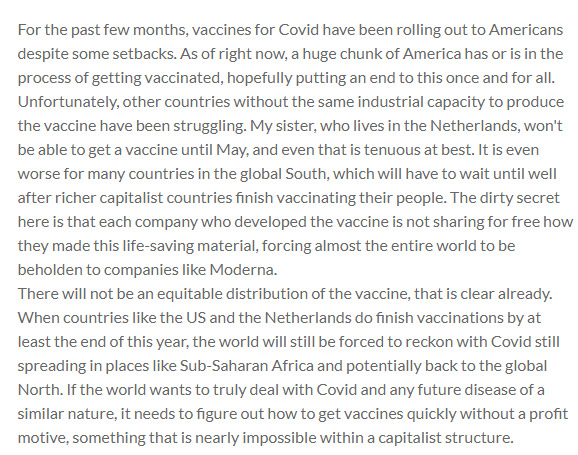 2021-04-18
2021-04-18Child care services in Illinois are getting prioritized
Northern Illinois University and an Early Childhood Transformation Team developed by Gov. J.B. Pritzker will work together to make getting vaccinations more obtainable. The primary goal for this movement is to make the process simpler. Most of the article refers to those in the child care industry, though. Pritzker intends to make it more accessible. Child care services have been struggling throughout the pandemic, and Pritzker has been trying to turn things around. Federal aid of $1.6 billion was allocated "to expand access to high-quality early childhood education and childcare for children and families across the state." Every demographic is to be included — children of color, children with disabilities, among others. -
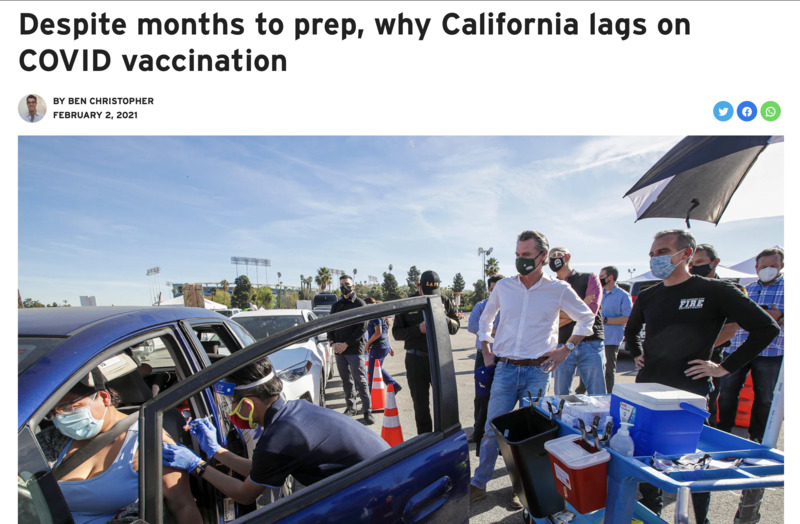 2021-04-18
2021-04-18What made California’s vaccine rollout so difficult?
The Golden state only recently received news that “50% of all eligible Californians have received at least one dose of the COVID-19 vaccine." It’s progress and it’s most certainly hope. What gives people even more hope is how they expanded vaccination eligibility to 16 and over as of April 15. Schools are already reopening, but this is good news for those who are still hesitant to return — and for good reason. What made California’s vaccine rollout so difficult? One of the most obvious answers is the size of the state. Its population was recorded to be over 39 million in 2020. Even with an increase in vaccines, with roughly 2.4 million doses in the first week of April alone, it was not enough to accommodate even the 50-64 age group — a population of roughly 7.2 million. Santa Clara County Executive Officer, Jeff Smith, was also quoted to have cited the state's governor for perpetuating the pandemic — that his pandemic approach was “disorganized and petulant.” Although affordable healthcare services is a nationwide pandemic in and of itself, California also deals with fragmented healthcare responsibilities. Distribution is “split up among 58 county governments.” Issues in communication, planning and transportation of vaccines are all major factors impacted by the overwhelming lack of unified leadership. https://twitter.com/CAgovernor/status/1383132361148100609 https://www.gov.ca.gov/2021/04/01/as-california-expands-covid-19-vaccine-eligibility-to-all-californians-50-governor-newsom-receives-vaccine-in-los-angeles/ -
 2021-04
2021-04COVID conditions for the homeless
This is a news story about some of the solutions to homelessness that people are trying in Phoenix. The specific solution covered was tenting for homeless people as a way to provide more protection and layers during COVID. It's especially important that this was a solution done in Phoenix considering how hot it gets here. With tents being the main way to "help the homeless" during COVID it shows a continued general disregard for homeless people and their health and safety. The article goes on to discuss broader criticisms and issues people have taken with the COVID-19 response specifically for homeless populations. I wanted to include this source because it shows a general disregard for homeless populations especially in the face of a pandemic that they are the most vulnerable population for. -
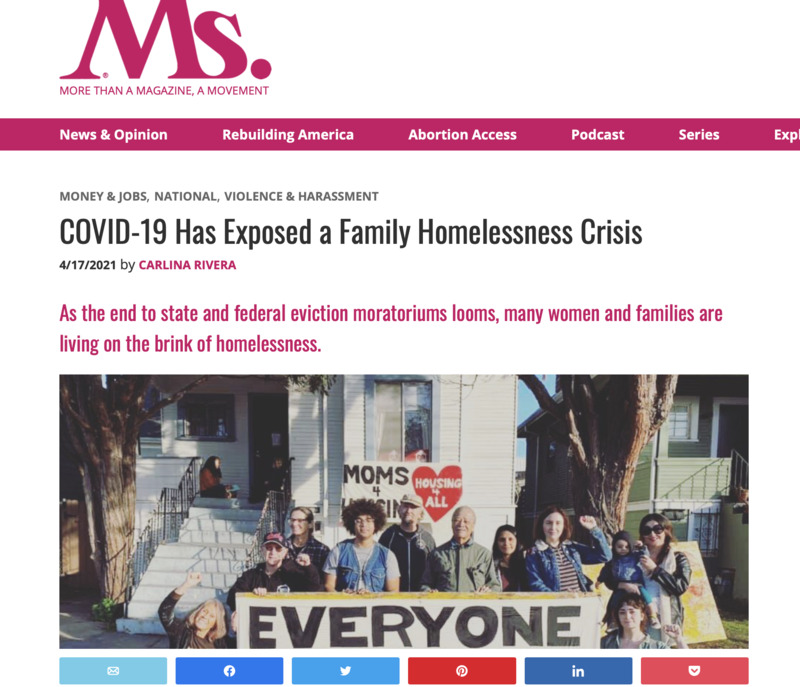 2021-04-17
2021-04-17The Crisis in a Crisis
This news article is about how COVID and homelessness have disproportionately affected families and especially black women. These are the two groups who are most likely to be benefitting from the rent moratorium right now. And as a result, they will be the groups most in danger of losing their housing once the moratorium expires. I wanted to include this story because it provides a perspective on homelessness that goes beyond people currently experiencing homelessness. People who are taking advantage of the moratorium are essentially on the verge of homelessness because they have no way to pay back that rent. This story highlights the fragile housing market and the economic situation that COVID placed many families under and the long-term economic consequences that come from this situation. -
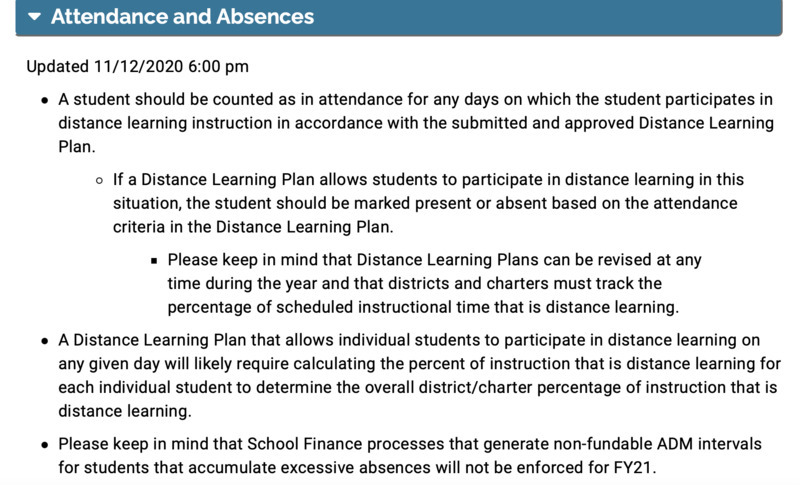 2020-10-16
2020-10-16School Finance Guidance for COVID-19
Arizona Department of Education fiscal information and guidance pertaining to attendance and absences while students participate in distance learning. The guidance page also includes links to important forms, school finance reports, and other valuable external resources. According to the report, the due date for a financial plan (Budget/AFR) is November 13, 2020. The name of the file is, "Distance Learning Report -Actual". No recent updates appear to have been made. -
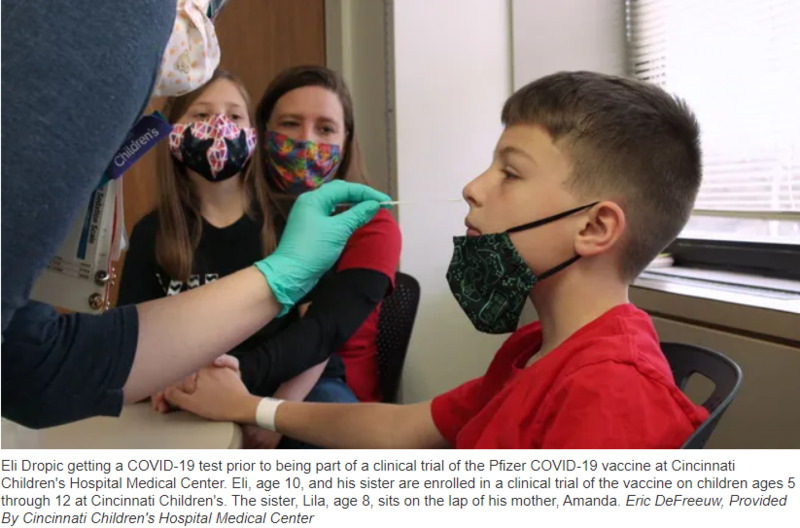 2021-04-13
2021-04-13How does the pandemic affect children?
This article speaks about the clinical trials that have begun in Cincinnati Children's Hospital Medical Center in hopes of getting a vaccine out for children as young as five years old. At the moment about 3,000 children have been on a waitlist to be involved in the trial. There are sites at which people are working to get dosage limits right for children ranging from 2-4 aswell. Many responses were collected by children on how they felt about being a part of the trial. Lila, a third-grader who is 8, was asked what was the best thing about participating in the vaccine trial, she replied, "knowing I might be able to not wear my mask anymore and knowing that the coronavirus vaccine is coming out." The effects the pandemic has on the children are visible as their hopes are to help the pandemic stop so that things go back to normal for them. -
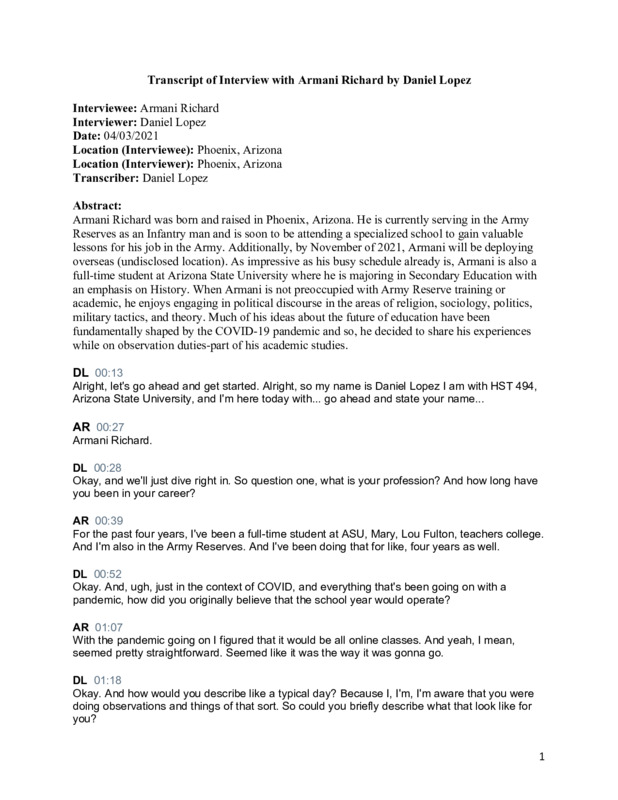 2021-04-03
2021-04-03Armani Richard Oral History, 2021/04/03
Conversation with Armani Richard and the impact of COVID-19 on Arizona education. Currently studying at Mary Lou Fulton Teachers College and fulfilling a promising career in the Army. -
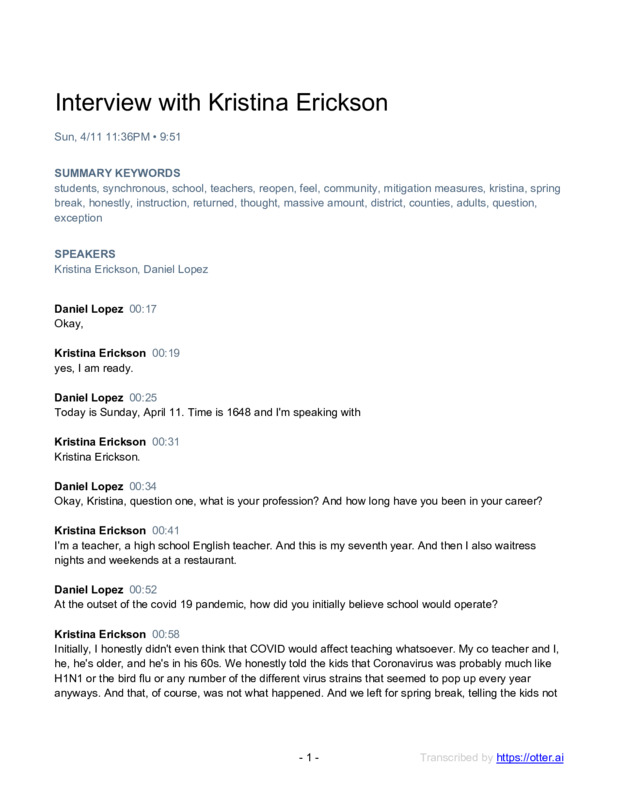 2021-04-11
2021-04-11Kristina Erickson Oral History, 2021/04/11
Conversation with Kristina Erickson an Arizona K-12 educator. Ms. Erickson weigh-ins on the March 15th executive order, in-person instruction, COVID protocols and procedures, and the future of education in her community -
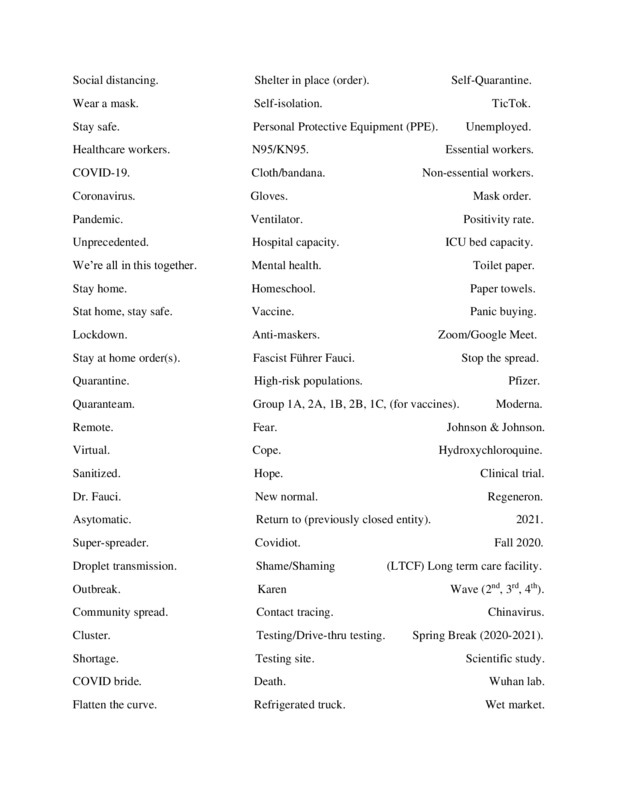 2021-04-12
2021-04-12Corona Vocabulary
This is a comprehensive (but not exhaustive) list of the most common Corona themed vocabulary used by in the U.S. While a definition of each term is not provided, linked websites provide context and explanations of many of the words. Culled from a variety of real world sources, what is most important about these terms is what their use says about the culture they created/were used in. From the use of everyday pandemic language, researchers can gain a window into the COVID experience in a way that is inaccessible even in photographs. These terms also show the United States was undergoing dramatic social and cultural change and some terms highlight the political conflict that was often meshed with Corona in the U.S. The vocabulary also shows a degree of conformity in U.S. culture as all of these terms became part of most Americans' vocabulary. The case of the work "healthcare worker" and "virtual" are two examples of this. Before medical staff, nurse doctor, EMT, online, distance learning, etc. were used to refer to these things, but now Americans have dropped them for the COVID versions. This shows how powerful Corona vocabulary has become. -
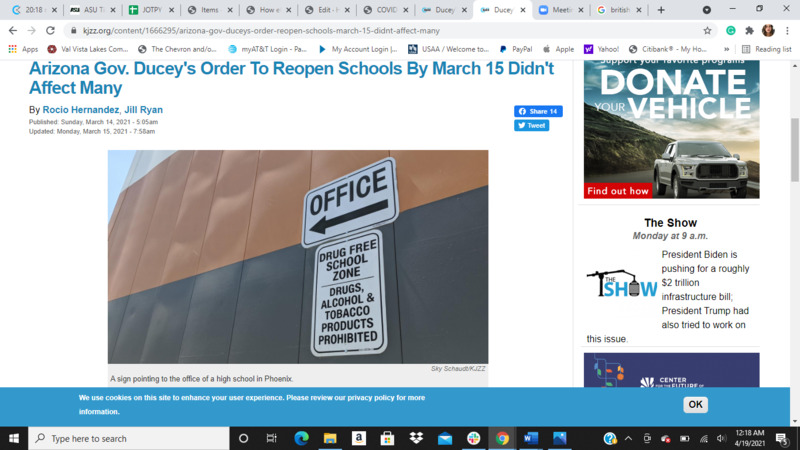 2021-04-11
2021-04-11How effective was Gov. Ducey's Order to Reopen Schools?
On March 11, 2021, the Arizona State Health Department reported seven counties, including Maricopa, were coded as "substantial transmission rate", however, this rate is technically one level under the serious risk categories. The remaining counties (six) were deemed "moderate" and were set to reopen by March 15. The NPR article argues about the irrelevancy of the order because more than half of the schools in the county are offering some form of in-person instruction, this order didn't change much for that particular school. For some schools, Osborn and Cartwright, the order actually sped their reopening date. In the Osborn case, school officials pushed for reopening because they confirmed that more than half of their teachers had been vaccinated. In places like Coconino and Pinal counties where transmission levels are exceedingly high, the school districts are exempt from reopening. Again, the effectiveness of the March 15th executive order is questionable at best. -
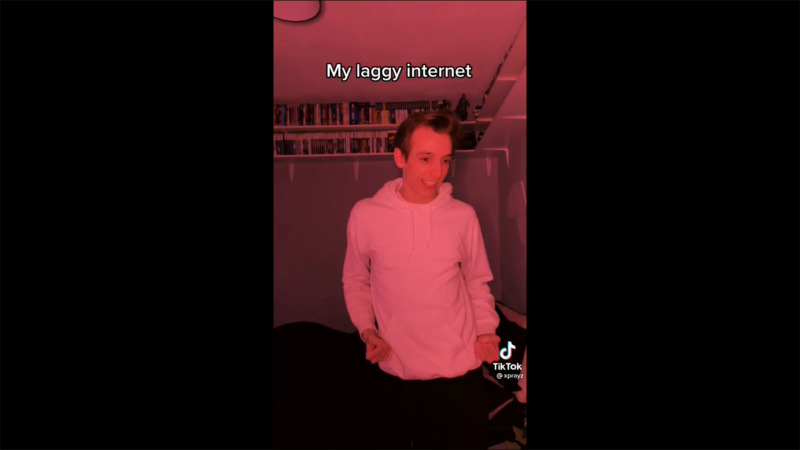 2021-03-21
2021-03-21Tiktok Trend involving Internet Outages
This video utilizes a Tiktok trend involving a specific audio as well as filter to illustrate internet issues an individual is facing. The audio is a clip from the song 'Got Me Good' by Ciara. -
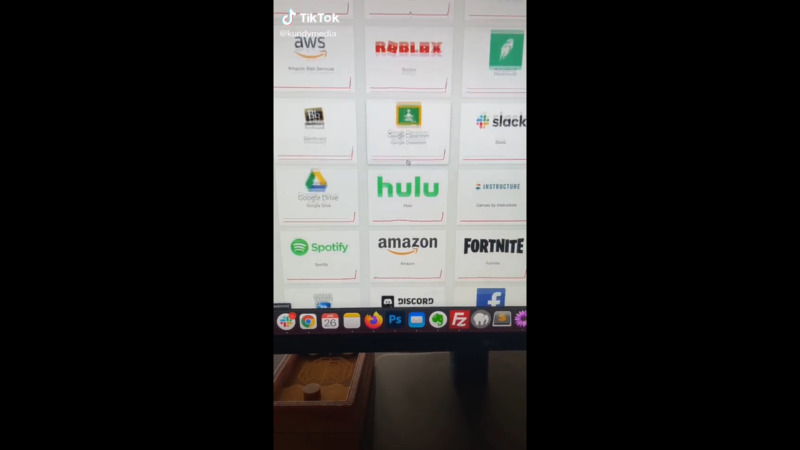 2024-01-26
2024-01-26Tiktok about Internet Outage/Site Outages
This tiktok is from an individual showing several site outages/internet connectivity issues across multiple major sites. The caption indicates that he was trying to complete his work when faced with this issue. He is utilizing a site that indicates which sites are down which is shown in the video. -
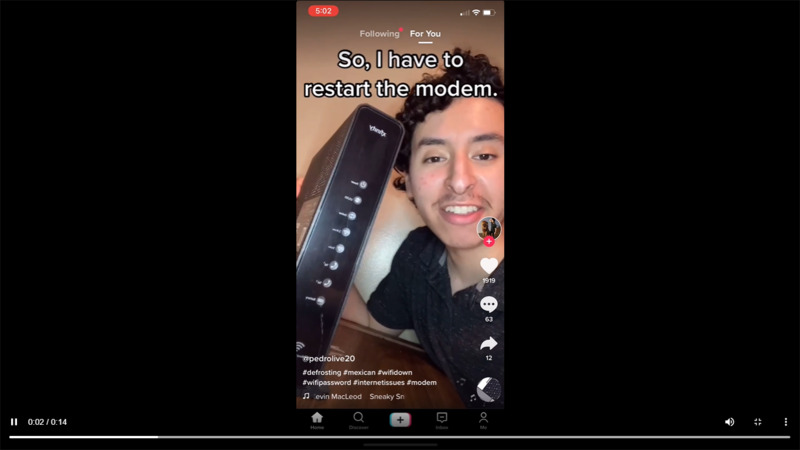 2021-03-11
2021-03-11Tiktok Skit about Internet outage
This short video from Tiktok is about an individual dealing with internet issues and being frustrated about connectivity issues. It seems in part to be satirical as he unplugs and plugs the modem back in. -
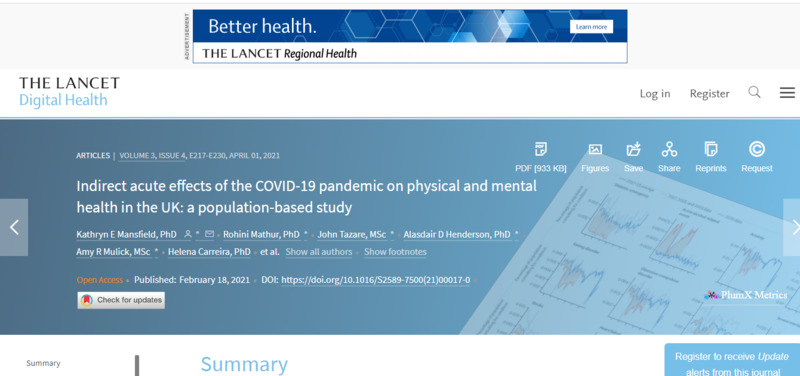 2021-04-11
2021-04-11Indirect acute effects on physical and mental health
This academic article is in the Lancet, a medical journal. I chose this because it is public, unlike some academic articles, and it is, as of right now, a pretty unique research article. Although it is done in the UK, it reviewed medical records, both physical and mental, from 2017 to 2020. The changes are a little surprising, as the largest reductions in health care at the start of the restrictions were diabetic emergencies, depression, and self-harm. This is something I have seen a lot in my research into the unintended consequences of the COVID-19 pandemic. Mental illness is the last thing to be cared for in a pandemic, or even in other natural disasters. The consequences on human health from this pandemic are only just now coming to light. This journal entry covers in-depth research and I highly suggest it. -
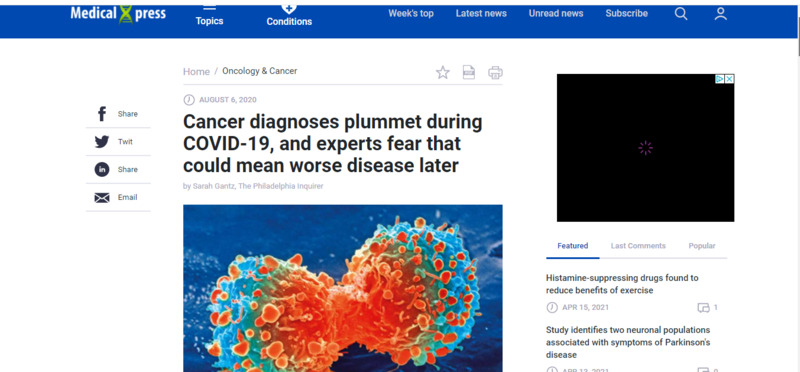 2021-04-11
2021-04-11Cancer diagnosis rates go down!
I know I have presented a pretty eye catching and exciting title, but the fact of the matter is, they aren't going down. The amount of people who have cancer has not plummeted, as the title suggests. Rather, the statistics have gone down. As the article states, "new findings offer grim evidence of the consequences of delayed care: A rise in undetected cancers that, when eventually diagnosed, may be more advanced and difficult to treat." I think this is a great reminder that statistics are not the people they represent, and many things effect the numbers. This is relevant to my research on the unintended consequences of the COVID-19 pandemic. -
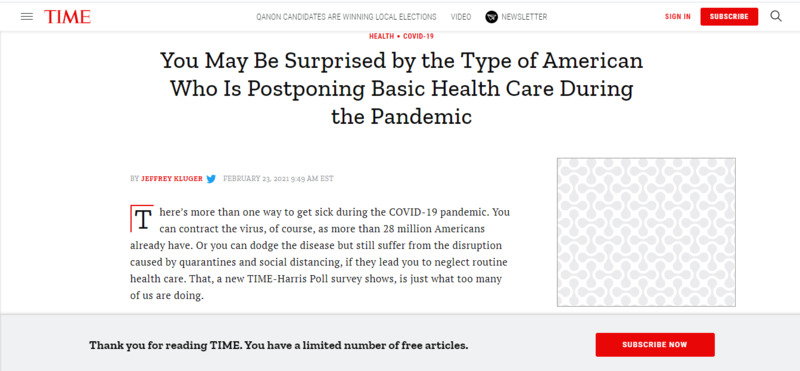 2021-04-11
2021-04-11Postponing Basic Health Care During the Pandemic
I have been researching the unintended consequences of the COVID-19 pandemic. One consequence that interests me the most is people missing important specialist appointments for things like heart disease or cancer. I would have assumed that it would be the lower class skipping these appointments the most due to the fact that is many cases it is already harder for lower class people to get to regular appointments. But this article proves my thought wrong, and states that the lower and middle class people have less opportunity to miss these appointments. They tend to have more healthcare problems, according to the article, and therefore need the appointments more. In addition, the numbers might reflect the fact that lower income people don't go to the doctor as much as higher income people in general, therefore the numbers were low to begin with. The article is a very interesting read and I highly suggest it. -
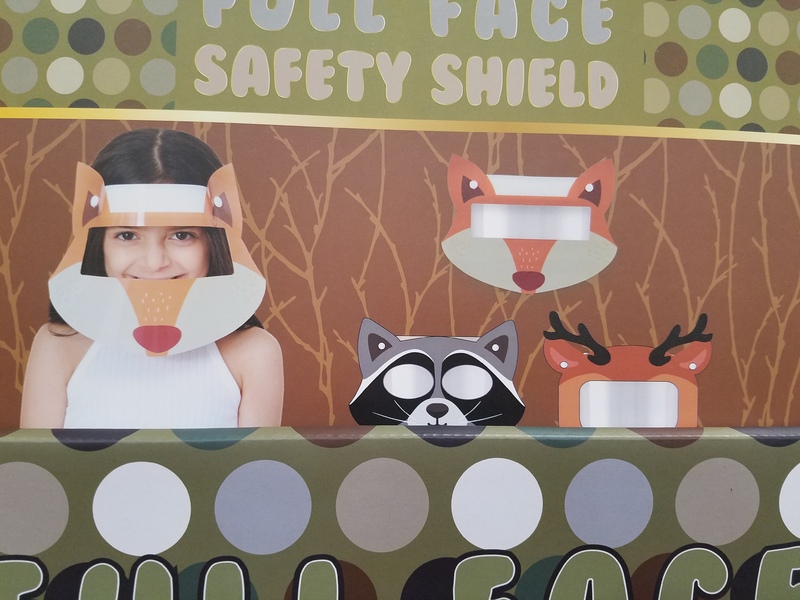 2021-01-21
2021-01-21Corona Culture Products
These pictures are a collection of Corona themed products from summer 2020 to January 2021. As you can see, there was a great variety of products and some of the most unusual appeared starting 2021. Of particular note is the coffee mug and a small wall plaque. Even the infant phrases "Social distancing" and "Healthcare worker" had crept into daily items in real stores. By fall, masks were being advertised in stores on long plastic hangers and had become just as common on random aisles as dish gloves, scrubber pads, and dryer balls. By January 2021, companies had begun to get creative with masks and shields. The final picture shows a set of children's face shields encased with the features of animal heads. This was likely to appeal to children who like to pretend to be animals. One company also began to make masks in small, medium, large, and extra large, to accommodate the variety of face shapes among the public (not pictured). The most important thing about all these products is that they show how deeply embedded Corona had become in United States culture despite the fact that it was not even a year since the virus appeared in the U.S. This indicates that companies were actively involved in both creating and maintaining a COVID consumer culture that tied what people experienced to what they could buy. Although more difficult to determine, it also shows a demand for such items both out of necessity (masks) and for leisure or fun (mug, animal shields). These items also reveal that COVID-19 was a highly unique event in that it was so marketable. No other event in the 21st century generated as much cultural/societal presence as Corona. These products should be further studied to see what better understanding about Corona can be gained from them. -
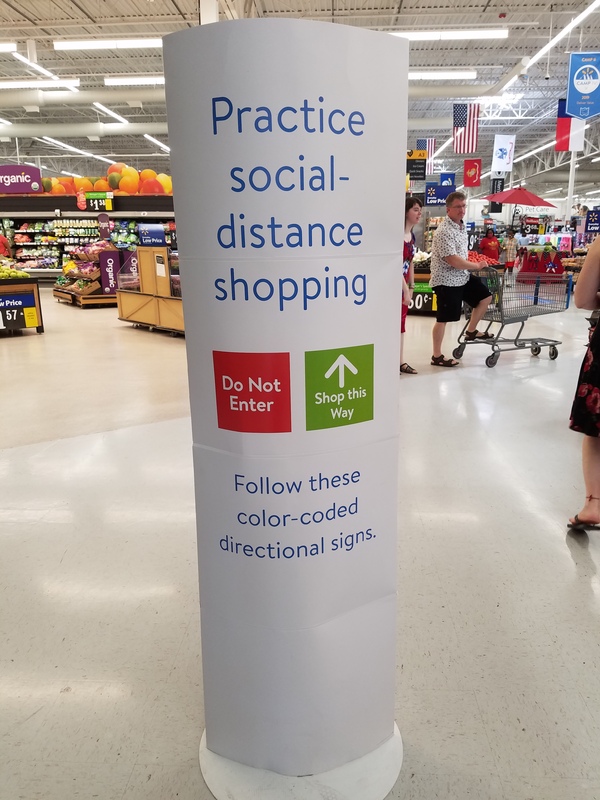 2020-05-28
2020-05-28One Way Only Signs in Texas Stores
These are pictures of one-way-only signs posted in a Texas Walmart on May 28th and June 11 2020. Many stores such as HEB, Target, and Sam's Club also had similar signs in there stores. The purpose of these signs was to encourage the public to walk in only one direction on each aisle of the store. Stores created an elaborate zig zag pattern using this method. At the time, it was thought that the risk of contracting COVID could be minimized by keeping people from congregating in the same space such as going in and out of the same aisle entrance. Some peopled followed the signs, but it was not a state law so others did not. These photos are important because they show the great extent stores took to try and minimize the spread of COVID. Stores were very concerned about projecting the image of a safe shopping experience in their stores. However, they also hint at the legalistic bent many COVID precautions were beginning to take on. Another implied effect of this arrangement was that by encouraging all people to go in the same direction, stores increased the risk that their customers might catch COVID-19 as everyone was to follow the exact path the person in front of them had. This was the type of situation these signs were supposed to prevent. -
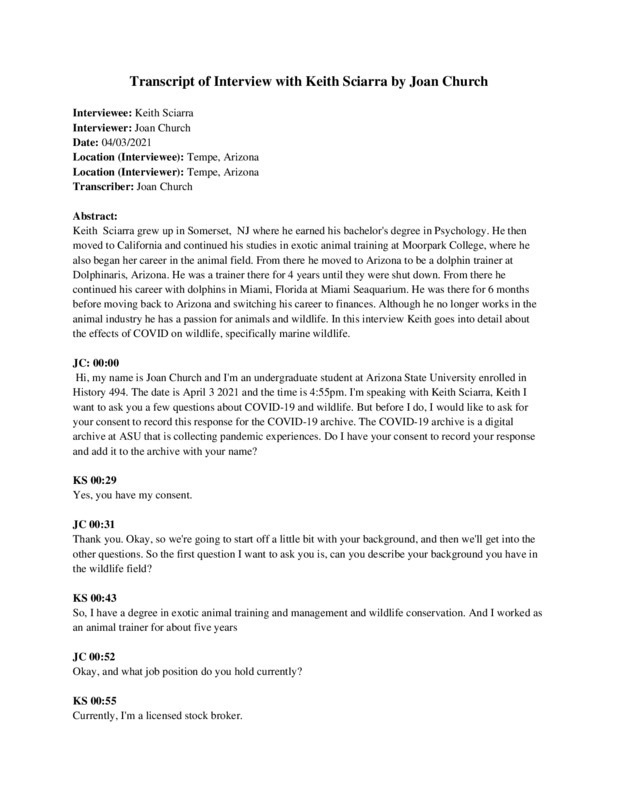 2021-04-03
2021-04-03Keith Sciarra Oral History, 2021/04/03
This is an oral history interview with Joan Church and Keith Sciarra. Keith gives his insight on how covid-19 has affected wildlife. Keith has many years working within wildlife, specifically with dolphins and ocean life. He gives us advice on how we can help the cause after covid and talks on the topic of ocean conservation. -
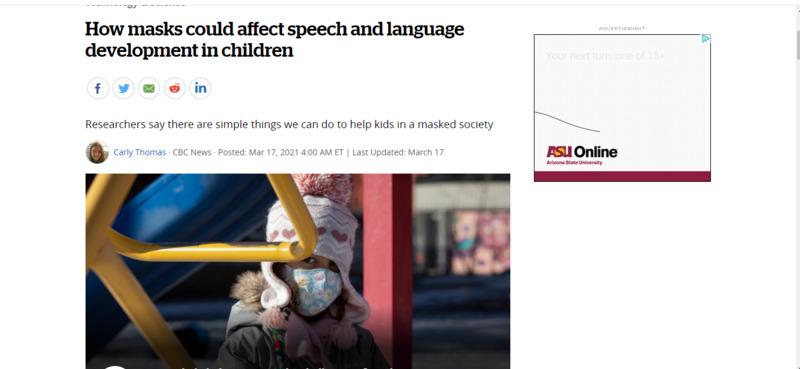 2021-03-17
2021-03-17Is Early Childhood Development Declining?
There are socialization concerns among adults and adolescents, and most are aware of the reasons behind that. However, children still in early developmental stages (infants, toddlers) may struggle in the long-term. The article primarily revolves around the words and expertise of senior scientist at Haskins Laboratories and a professor adjunct at the Yale Child Study Center, David Lewkowicz. There are physical, emotional, and mental struggles that could negatively impact early childhood development. Examples of these struggles are with how they learn languages by visual and auditory associations, which can be difficult with masks. Another related to masks is facial recognition. Lewkowicz isn't filled with bad news, though. More time and direct attention given to face-to-face interactions and more explicit expressions of emotions can help compensate. These early years are when children are very adaptable as they take in the world around them, so there is hope for more perceptive children coming out of the pandemic rather than a decline. -
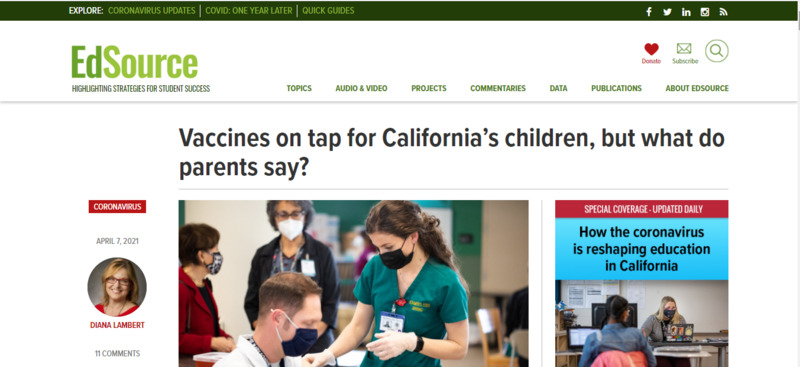 2021
2021Vaccine Eligibility Expanding to Adolescents, Californian Parents React to Schools Reopening
California is soon expanding their vaccine eligibility to 16 and older on April 15, 2021. The plans for expanding it even more aren't expected to be for sometime. However, the announcement from Pfizer-BioNTech stating that the vaccine is safe and effective for 12 and older does give some hope for a quicker time frame. The is a focus on giving children and adolescents back their youth. There are schools opening with hybrid instructions (online and on-site instruction), but there the on-site hours are always rotating students to minimize crowd interaction. The article goes on to include opinions from parents of adolescents, which emphasized the importance of getting everyone (school faculty and students alike) vaccinated. Everyone seems eager to get back to pre-pandemic life as soon as possible, so the eligibility expansion does receive as good news and gives the public hope. Naturally, however, it’s not all good news as people need to remain informed and cautious. The article reminds us that variants of the virus have the potential to harm younger children. Notably, it’s the B117 strain that’s been said by Dr. Michael Osterholm, director of the Center for Infectious Disease Research and Policy at the University of Minnesota, that can be “50% to 60% more contagious than other strains of Covid-19” from his observations of Minnesota schools. -
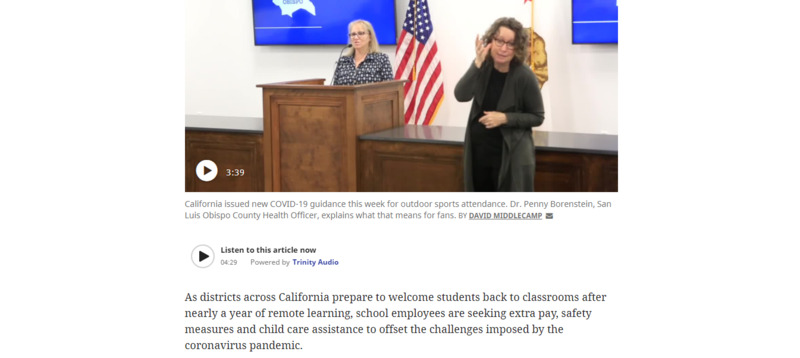 2021-04-10
2021-04-10Child Care Concerns Persist Despite Returning to In-Person Instruction in Californian Schools
Californian schools are opening back up, but there continue to be concerns over employees and their families. Although there have been some employees working at schools the past year (i.e. custodians), those working remotely (i.e. teachers) continue to face challenges in child care. Due to this, "Los Angeles Unified School District earlier this week announced it would provide a day care stipend of $500 a month for each child under age 5 to all full-time employees, including teachers." The Service Employees International Union (SEIU 1021) did clarify within the article by Sacramento Bee that some demands could not be met. Among the demands was a one-time stipend amount of $1,500 for employees with children aged 3 - 14. This is an ongoing issue with its latest update on April 10, 2021 being: a weekly stipend of $125 for employees with children aged under 14. This represents one of the issues employees of educational institutions are facing. They’re hesitant to return to in-person instruction. Although there’s a fair amount of news coverage of children returning to school, the ones hesitant (especially those responsible for the school to run smoothly) should also be acknowledged. -
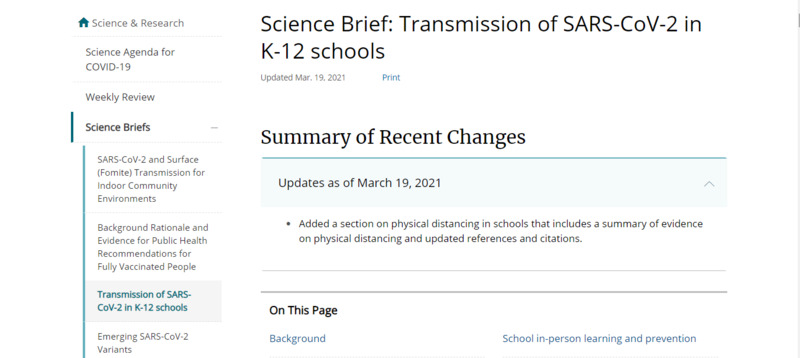 2021-04-10
2021-04-10CDC Science Brief: Transmission of COVID-19 in K-12 schools
(updated March 19, 2021) CDC report on scientific findings in terms of COVID-19, children, adolescents, and the unlikely transmission potential among these two groups (18 or younger). The experiences of other countries opening at various points during the pandemic contribute to the knowledge laid out in the report. One example of a recommended prevention strategy, physical distancing, is explained as a determining factor in preventing transmission. Yet, as the research shows, the prescribed 6-foot distance is less of a stress point when observing children and adolescents. In other words, several US studies have found low transmission rates when children are separated less than 6 feet. The same applies to children and adult interactions. -
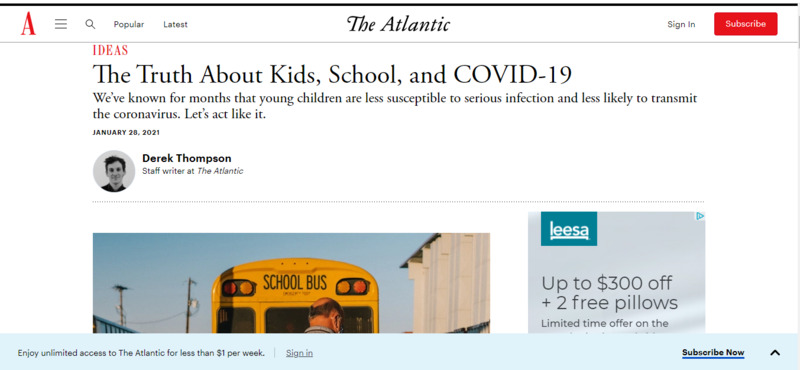 2021-04-10
2021-04-10Children, School, and COVID-19
This article, from The Atlantic, analyzes the Centers for Disease Control and Prevention (CDC) assertion that adequate ventilation, proper face coverings, and social distancing in schools will prevent transmission and a surge in COVID-19. The CDCs argument, which the author of the article fully supports, bases their support for in-person instruction on the "preponderance of available evidence," which includes both US studies and European. According to the CDC, people under 18, and young children especially, are less likely to infection and less likely to suffer severe symptoms. Moreover, one comprehensive plan to return children to the class includes access to vaccinations, high-quality scientific information, and strict COVID protocols. -
 2021-03-31
2021-03-31Mohammed Husain Oral History, 2021/03/31
This interview speaks about a teenager, Mohammed Husain, who has described her life through the course of the pandemic including how she has felt what she had experienced including some losses, things that have changed and ways she has coped. The set of questions provided are descriptive and offer directed questions that allow the interviewee to answer them thoroughly. Mohammed speaks about how she felt lonely during the pandemic. She describes things she has missed such as shopping going out with friends and effects on her mental health. She has also spoke about the limitations and how they have made her enjoy her own presence and made her evolve into a person who enjoys her own presence. She lists some positive aspects of the pandemic including closer relationships with family members along with a time to reflect on her own self. She has included that she has taken advantage of the time of the pandemic to really look back on her life and understand the moment as not everyone in their lifetime gets to live through such a scene. -
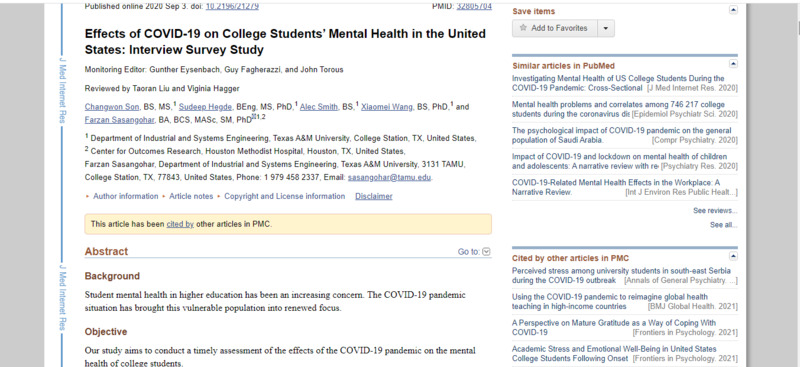 2020-09
2020-09College Students During COVID
This is a story about how college student's mental health has been affected during COVID as a unique population. I wanted to include this to provide context about why my interviewee may have been reluctant to seek out resources due to the extra stress that he had been experiencing. This study goes into how the factors that college students, in particular, are experiencing. This article was done by a survey and shows how common these feelings are that may have deterred students from seeking help due to stress. -
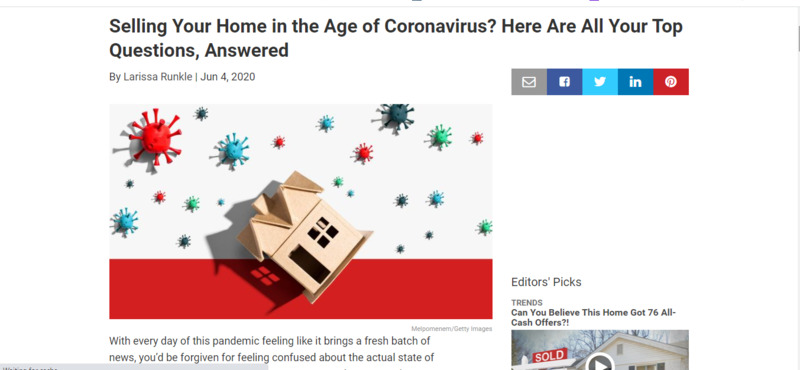 2020-06-04
2020-06-04Selling during COVID
This is an article about selling a house during COVID. I wanted to include this source because one of my interviewees discussed some of the anxiety and stress that they experienced while trying to sell their home in March of 2020. This article provides context for what it is like to sell a home during COVID and how that market has changed. This article is by a realtor and provides advice and comparisons to what it may be like to sell a home during COVID and how that compares to selling during another crisis such as a recession. -
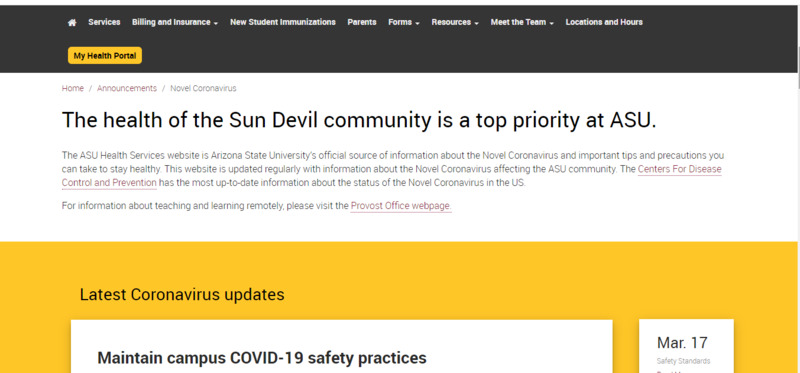 2021
2021ASU COVID Resources
This is the Arizona State University-specific COVID-19 resources for students. I wanted to include this University's specific resources because one of the people I interviewed attends ASU as a student and I want to provide this source as a supplement for some of the difficulty that he mentioned having in finding resources while living as a person experiencing housing instability. The website houses all messages and updates the university has sent to students with regard to the Coronavirus. The site focuses on health and staying healthy for students but seems to lack a clear guide on how to access resources and aid that students may qualify for. -
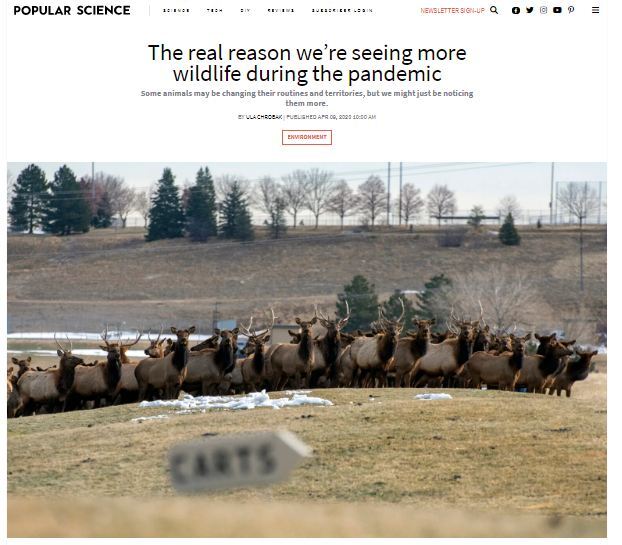 2020-04-09
2020-04-09Why are we seeing more wildlife during the pandemic
This article is important because it discusses why we are seeing more wildlife out and about during the pandemic. They discuss the topic of “is more wildlife out, or are people just noticing wildlife more?” and other topics related to this. This article also discusses the difference between seeing bigger or smaller animals and the reasoning behind it. This article gives a good insight on wildlife during the pandemic and reasons for more sightings. -
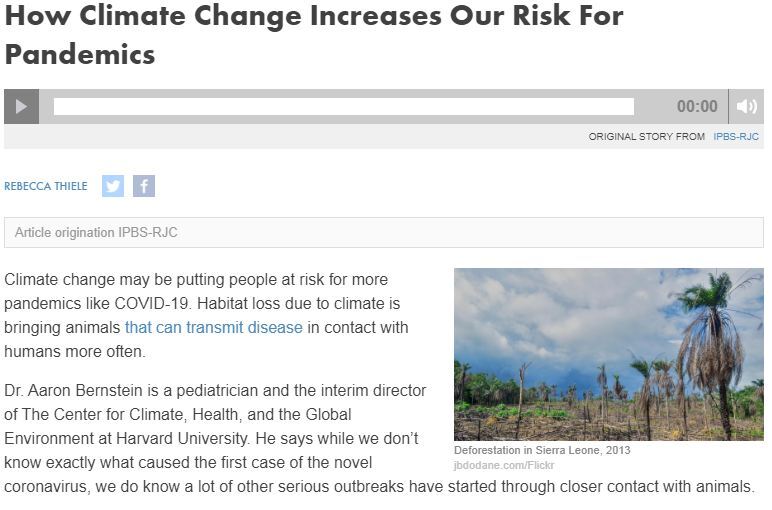 2020-03-24
2020-03-24Climate change, Wildlife, and the pandemic
In this article by PBS it is discussed how climate change, wildlife, and the pandemic all have a connection. One of them being that with more habitats for wildlife being destroyed, the higher risk for contact with wildlife increases which increases the chances of another pandemic. This is a short but informative article and they interview a doctor from Harvard as well who gives his input to this topic. He explains that direct contact with animals is the cause of the pandemic and if we do not do something about this soon, it will just reoccur again. -
 2020-08-06
2020-08-06Widlife Sightings during COVID-19
This journal entry is important because it gives insight as to why the wildlife sightings were important to note during the pandemic. During the pandemic it was noted by many people across the world that wildlife was a lot more active and out. This could be for a variety of reasons, some of the obvious reasons being that there is less human interaction and traffic therefore the wildlife feels comfortable exploring. This journal entry also explains how it may just be that people are noticing wildlife more, not that there is more wildlife. This journal explains how wildlife scientists were able to study them during the pandemic period which can help answer long term questions. -
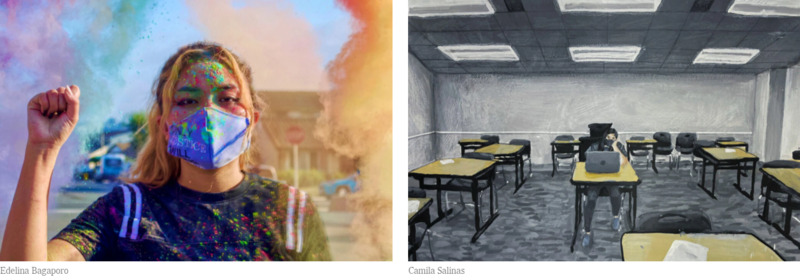 2021-04-08
2021-04-08How does the pandemic affect children?
This article titled "Coming of Age" is a great article that provides various art pieces from children all around the world. Who, through their art display the feelings they feel during the pandemic, certain stepping stones of their life that they were unable to celebrate fully, and even self-development that was limited. More can be said about the article by looking at the images provided and the unique descriptions below them. -
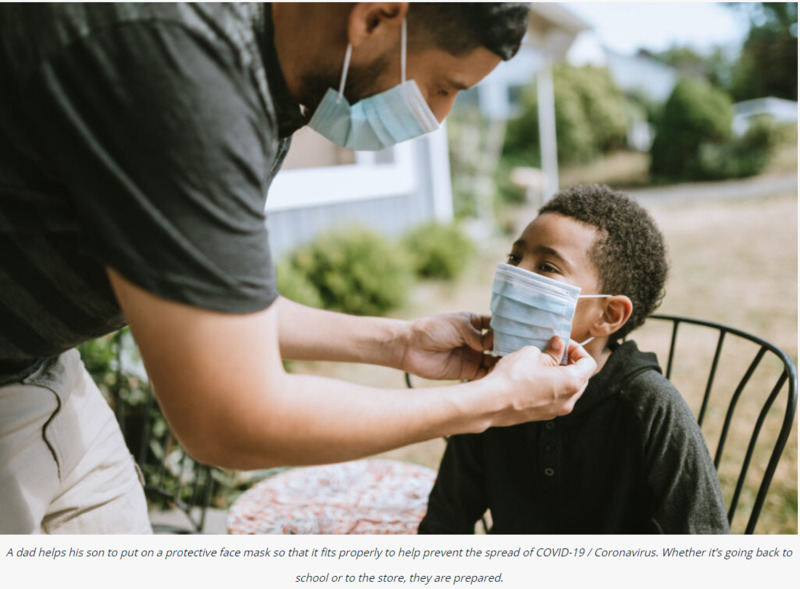 2021-04-08
2021-04-08How does the pandemic affect children?
This article speaks about obesity in children during the pandemic. With lots of parents work being closed as well as schools, parents struggle to provide healthy options to children and are stuck with buying cheaper option that is mostly filled with preservatives and high calories that is causing obesity rates to increase. Effects of diet during youth effects eating habits that a child developss as it grows. As weight plays a role mentally and physically in a person's health, the pandemic affects children in such away. -
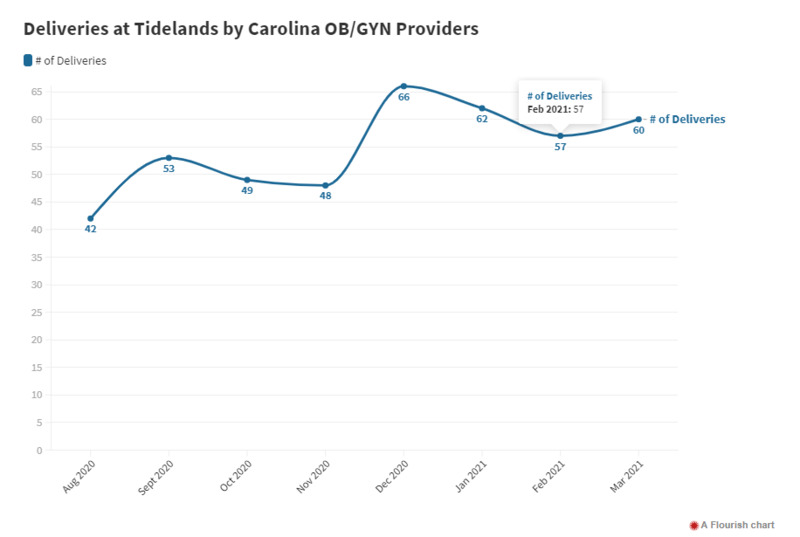 2021-04-08
2021-04-08How does the pandemic affect children?
This article speaks about birth rate spikes around the world during the pandemic. The chart provided shows birth increases. Many families are now welcoming children after 5-6 years. This is described as the next baby boom. The correlation this has with my research topic involves the idea that increased birthrates, and their effects on children at home along with the development of these children as they are born in the middle of the pandemic. -
 2021-04-03
2021-04-03Presley McBride Oral History, 2021/04/03
This is an interview with Presley McBride about how Corona Culture has affected her personal life and United States Society. Presley first describes any pandemic-related purchases or activities she has participated in and also highlights how her favorite Youtube personalities have incorporated COVID crafts into their shows. She also includes reflections on the impact of plexiglass shields and sanitization on human interaction and socialization. Presley also touches upon the political divide caused by a sense of shame that people in society feel when they are pressured to get vaccinated or wear a mask. Presley includes a description of how businesses have been using more packaging to protect their products since the start of the pandemic. Finally, Presley shares her insights on the negative effects of the stay-at-home mentality on U.S. mental health and culture. Contributed by Kayla Phillips, URE, for Arizona State University for the #CoronaCulture, #HST494, #ASU, #Texas #OralHistories collections. -
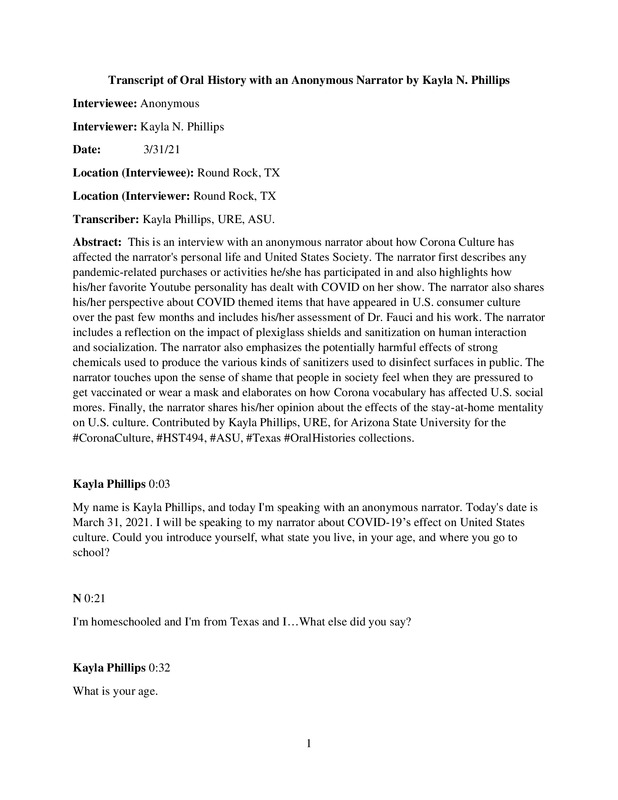 03/31/2021
03/31/2021Anonymous Oral History, 2021/03/31
This is an interview with an anonymous narrator about how Corona Culture has affected the narrator's personal life and United States Society. The narrator first describes any pandemic-related purchases or activities he/she has participated in and also highlights how his/her favorite Youtube personality has dealt with COVID on her show. The narrator also shares his/her perspective about COVID themed items that have appeared in U.S. consumer culture over the past few months and includes his/her assessment of Dr. Fauci and his work. The narrator includes a reflection on the impact of plexiglass shields and sanitization on human interaction and socialization. The narrator also emphasizes the potentially harmful effects of strong chemicals used to produce the various kinds of sanitizers used to disinfect surfaces in public. The narrator touches upon the sense of shame that people in society feel when they are pressured to get vaccinated or wear a mask and elaborates on how Corona vocabulary has affected U.S. social mores. Finally, the narrator shares his/her opinion about the effects of the stay-at-home mentality on U.S. culture. Contributed by Kayla Phillips, URE, for Arizona State University for the #CoronaCulture, #HST494, #ASU, #Texas #OralHistories collections. -
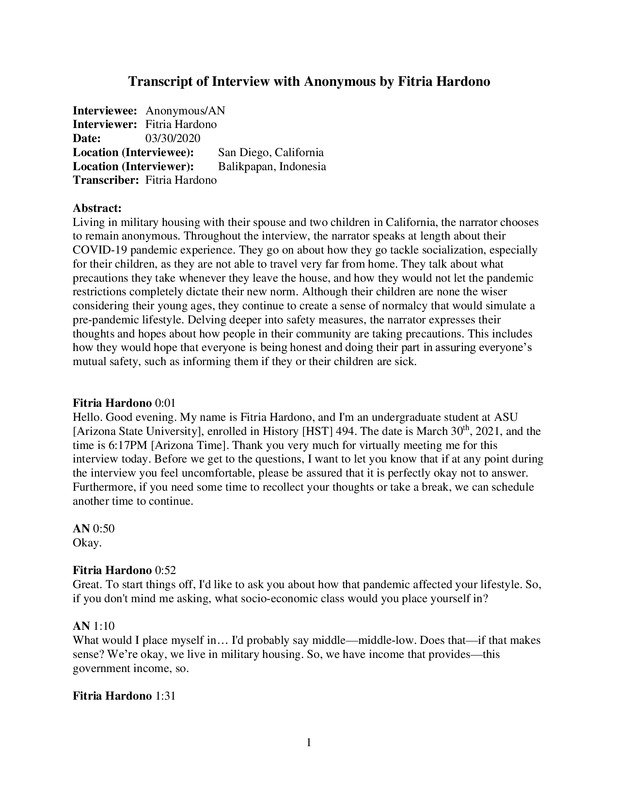 03/30/2021
03/30/2021Anonymous Oral History, 2021/03/30
Living in military housing with their spouse and two children in California, the narrator chooses to remain anonymous. Throughout the interview, the narrator speaks at length about their COVID-19 pandemic experience. They go on about how they go tackle socialization, especially for their children, as they are not able to travel very far from home. They talk about what precautions they take whenever they leave the house, and how they would not let the pandemic restrictions completely dictate their new norm. Although their children are none the wiser considering their young ages, they continue to create a sense of normalcy that would simulate a pre-pandemic lifestyle. Delving deeper into safety measures, the narrator expresses their thoughts and hopes about how people in their community are taking precautions. This includes how they would hope that everyone is being honest and doing their part in assuring everyone’s mutual safety, such as informing them if they or their children are sick. -
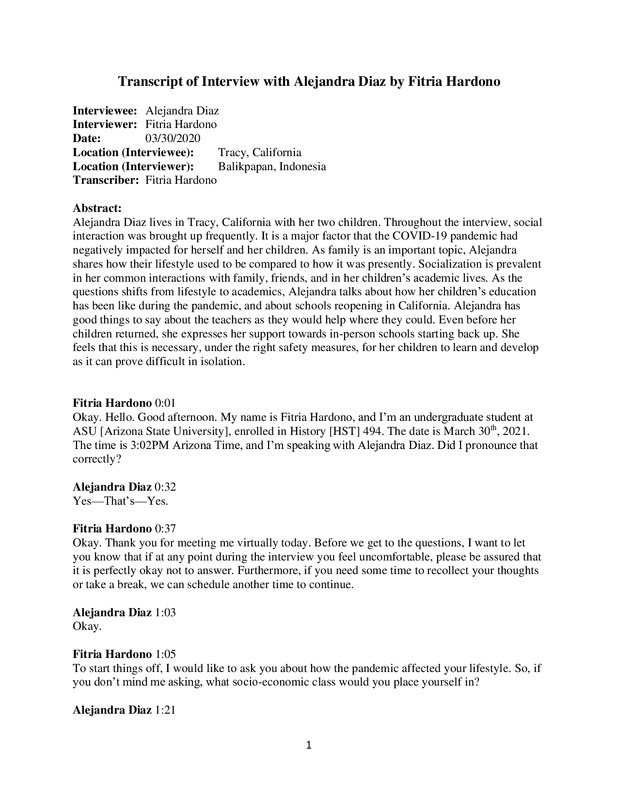 03/30/2021
03/30/2021Alejandra Diaz Oral History, 2021/03/30
Alejandra Diaz lives in Tracy, California with her two children. Throughout the interview, social interaction was brought up frequently. It is a major factor that the COVID-19 pandemic had negatively impacted for herself and her children. As family is an important topic, Alejandra shares how their lifestyle used to be compared to how it was presently. Socialization is prevalent in her common interactions with family, friends, and in her children’s academic lives. As the questions shifts from lifestyle to academics, Alejandra talks about how her children’s education has been like during the pandemic, and about schools reopening in California. Alejandra has good things to say about the teachers as they would help where they could. Even before her children returned, she expresses her support towards in-person schools starting back up. She feels that this is necessary, under the right safety measures, for her children to learn and develop as it can prove difficult in isolation. -
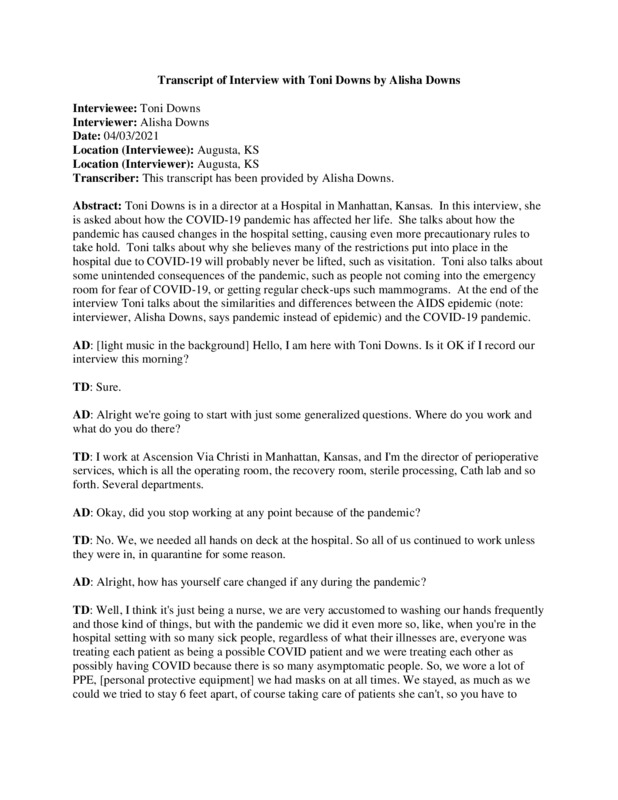 2021-04-03
2021-04-03Oral Interview with Toni Downs
Toni Downs is in a lead position at a hospital in Kansas. In this interview, Toni tells me about changes that have occurred at the hospital as a result of the COVID-19 pandemic. She also discusses the long term changes she suspects will stay in effect, such as visitation regulations to the hospital. Toni tells me about similarities and differences between this pandemic and the start of the AIDS pandemic. She also discusses how the number of people going to the emergency room have dropped significantly, more than 75% at the start of the pandemic. Toni believes if we all work together at stopping the spread, we will get this under control. However, she thinks many things may stay around for a while in the hospital setting, such as the before mentioned visitation rules, and even mask wearing, in order to protect hospital staff and the patients. I am researching the unexpected consequences of the COVID-19 pandemic, such as people skipping mammograms for fear of catching COVID at the doctors office. I chose to interview Toni for my research, due to her insider knowledge of the inner workings of a hospital.
